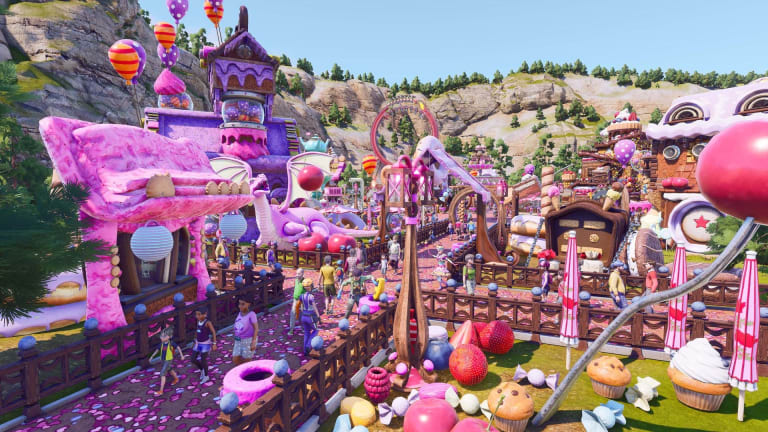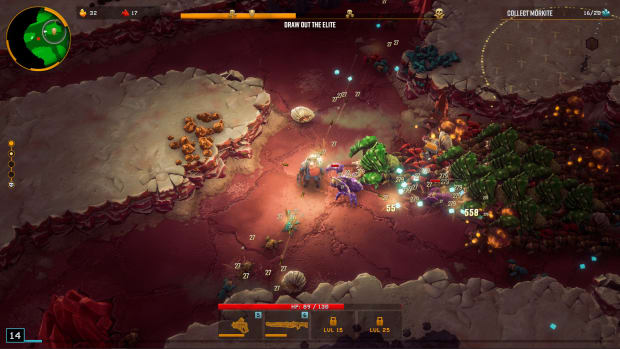
Park Beyond review: impossification successful

Being an engineer of roller coasters isn’t easy – it’s all safety regulations here, physics making a fuss there, ‘they’ll sue us if you do this’ bla bla bla. I’ve had enough. I quit. You can’t tell me what to do anymore, Karen. I don’t care about your engineering and physics and law degrees. I’m building my own roller coaster – without tracks and with a cannon that’s going to shoot the passengers right under a rock arch in the middle of a desert, passing some cliffs I’m lining with animatronics of Wild West bandits that “shoot” at the rides going by. And then I’ll put a similar coaster right next to it so it feels like the passengers are racing each other.
Wait, am I seriously building the pod racing scene from Star Wars: The Phantom Menace? I guess so. Park Beyond just lets me do it.
Welcome to an enormously fun and physics-bending theme park builder developed by Limbic Entertainment and published by Bandai Namco that’s in many ways completely normal and typical for its genre.
You construct pre-built as well as custom rides, place queue paths, build food stalls and toilets, and generally create a nice-looking park for your visitors and yourself to enjoy. You need to hire staff to keep it clean, maintain the infrastructure, and entertain the masses, making sure you’re not overworking your employees if you want them to perform at their best. As your park grows and attracts more attention, you can unlock additional buildings of all kinds, get more decorative themes – from Wild West to Da Vinci, every aesthetic is served. It’s all quite bread and butter, really.
There are three types of visitors you can tailor your park to: teenagers, families, and adults. Every attraction and eatery you can build will be enjoyable for some groups and not so much for others, so you’ll have to make a decision at some point to cater to a specific set of customers or be very careful about balancing things – it’s difficult to please everyone equally. The themes and aesthetics mentioned above don’t actually figure into this, so you can always decorate your park in whichever way you prefer, which is nice.
In the campaign, you’re actually asked to make some decisions in this direction before you even start your next mission. You’ll attend a pitch meeting and depending on which dialog options you choose, the following mission will be focused on certain target audiences, starting you off with a different set of structures and themes – that lends itself to replayability outside of the sandbox mode and is a unique touch for the story mode. For those of you who just want to get building without all the chatter the dialog is actually skippable, bringing you right to those decisions.

Even before the pitch meeting, you can explore the play area and find useful information on key locations.
Limbic Entertainment / Bandai Namco
The characters featured in the story and those meetings are all fully voiced and colorful – the entire game looks vibrant, perfectly adding to the playful theming. They’re also incredibly stereotypical: the stingy executive, the over-excited adrenaline junkie advisor, the dreamy old mentor, and the ambitious engineer. If you’ve played one building game, you’ll know them well.
There is plenty of park management to be done in Park Beyond, though it’s all relatively simple and veteran managers might find themselves without much of a challenge in this arena. Aside from staff management, you’ll have to keep an eye on ticket prices and the entry fees for individual rides, of course. You can even adjust the menus and prices of your individual food and drink stalls, though, which is encouraged by little events that pop up and make, say, a certain energy drink trending for a bit. Customers will then not only expect to buy it in your park, they’ll do so at a premium price and will be all the much happier for it.
The UI is well designed and gives you all the information and tools you need to identify potential problems in your park and remedy them. Various heat maps give you a great and simple-to-use overview of hungry or thirsty customers, people needing a toilet etc. so you’ll know which areas may need additional infrastructure. The game is good about giving feedback.

Several heat maps and overlays provide an easy access to key information about your park.
Limbic Entertainment / Bandai Namco
You’ll have some pretty vanilla rides at your disposal at the start – things you’d see in the real world. The charm of Park Beyond is that, as suggested in the game’s title, it quickly transcends that normality. Your attractions and even some shops can be ‘impossified’ – i.e. you can throw off the shackles of physics and safety regulations and go to town. That regular Kraken ride throwing a submarine-shaped passenger cabin through the air suddenly gets a lot bigger, a lot more violent, and, boy, did I have to stop using the first-person view, which is available for every ride and lets you experience everything from the perspective of your customers.
Attractions get bigger and more imaginative as you progress and lend themselves to doing lots of vertical park design – if you wish, you can layer your park like an anthill with paths leading up and down, attractions on different levels and wagons of rollercoasters propelled by giant cannons flying through the air. This is made possible by the snappy building system, which makes creating paths easy – even ones that go and down in serpentines.
You can check what people think about your rides in an easily-accessible sub-menu and then adjust things accordingly to make it a hit. At some point you may be forced to get rid of old rides and replace them, though, because novelty wears off and people are always looking for fresh experiences – a new paint job, for which you can even use hex numbers, may not be enough.

Impossification isn't just available for roller coasters, but also for flat rides and shops.
Limbic Entertainment / Bandai Namco
Now, the real crown jewel of Park Beyond is, of course, building your own roller coasters, vanilla or impossified. Laying out the tracks is smooth and you can do it all manually or rely on the various premade modules at your disposal to construct loops and inversions. While you’re busy with construction, test wagons will be on track at all times to show you where the speed is too high, the track is too steep etc. – you can stretch physics only to a certain point: if your ride is too fast for the corner you’ve planned, it’ll fall off track and kill all passengers. That’s not great for publicity.
You’ve got all the normal tools of roller coaster building at your disposal – pulleys to get your wagons over a steep portion of the course, brakes to slow them enough to get them around corners safely, and all the rest. Then there are the impossified modules like giant cannons, bubbles that let wagons run on a water surface, ramps to catapult them over cliffs – truly, the possibilities are endless. You can also tunnel and terraform to your heart’s delight, shaping the world around you as you need it to be to make your vision come to life.
Before placing down any track, you’re asked to give some personality to your new roller coaster by choosing a certain type and some hooks, which are used to categorize them as attractive or not attractive for the three customer types. Each decision you make here will give you specific conditions you need to fulfill while building your tracks – like a certain number of inversions or loops or the usage of a specific module to make good on those promised hooks. This embeds the coasters into the park’s theming and gives you some design principles to work around.
Park Beyond is a fabulous theme park builder with vibrant aesthetics, rock-solid controls and UI, and satisfying mechanics – and thanks to the power of impossification, the game has a much longer staying power and more variety than many other representatives of its genre. The game does exactly what it promises: It lets you build your wildest dreams.
Score: 8/10
- Technical performance: 7/10
- Visuals: 8/10
- Audio and music: 7/10
- Mechanics and systems: 9/10
Park Beyond: Technical breakdown
Technically, the game runs smoothly on my high-end PC – no big lags, crashes, or aggravating bugs and glitches. Frames definitely drop once your park gets bigger and more is going on, but never to a critical point. There are some clipping issues with guests not exactly lining up with paths or somehow floating above the roller coaster seats they’re supposed to sit on. These instances have been vastly reduced since the preview build and seem to be pretty rare now, but they are noticeable when they happen.
The pathing seems to hold up very well, even in more extensive parks. Groups do collide and hinder each other sometimes, but that did not have any discernible negative effects – there were no traffic jams bringing the park to a standstill and people weren’t hindered from going to the toilet or entering an attraction in any of my sessions. Other times groups just walk through each other, so all that looks a bit inconsistent and iffy in a purely visual sense, but you won’t actually notice it much from the top-down view you’re in most of the time.
Platform tested: PC.



